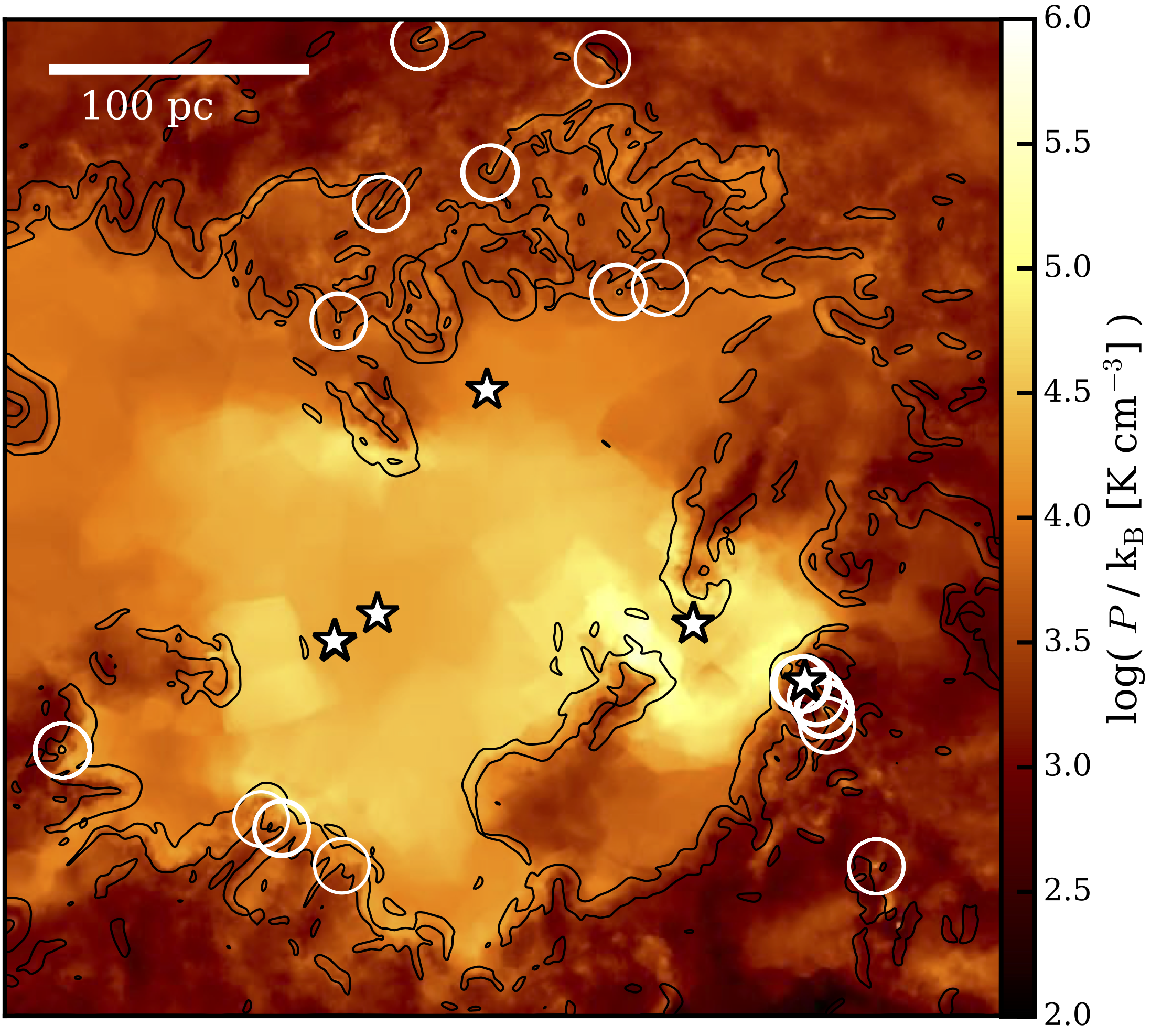The LYRA project
Please feel free to use the movies below for talks or outreach purposes. If you do, please cite Gutcke et al. 2022109M⊙ halo forming in a filament
Projected gas densityWe see the gas collapsing along a small dark matter filament
Reionization sets in around z~8, heating all the gas in this shallow potential and making it appear "fuzzy"
Halos above 106M⊙ are seeded with the first metals
Stars and supernovae in these "PopIII" halos then proceed to expel additional metals into their vicinity
Supernovae "twinkle" into existence in the densest gas
Individual hot bubbles expand and merge into a single hot super-bubble
Reionization can be seen as an increase in the background temperature after z~8
Cosmological dwarf galaxy with resolved supernovae
The first cosmological LYRA (Gutcke et al. 2022) simulation is a zoom-in on a 2x109 M⊙ halo mass cosmological dwarf galaxy run to z=0 at 4 M⊙ gas resolution with resolved supernova feedback. We investigate three simple subgrid implementations for the inhomogeneous chemical enrichment from Population III stars ("metal seeding") and compare them to constraints from Local Group dwarf galaxies.
The employed model, LYRA, is a novel high resolution galaxy formation model built for the moving mesh code AREPO, which is marked by a resolved multi-phase interstellar medium, single stars and individual supernova events. The resulting reionization relic is characterized by a short (<1.5Gyr) star formation history that is repeatedly brought to a standstill by violent bursts of feedback. Star formation is reignited for a short duration due to a merger at z~4 and then again at z~0.2-0 after sustained gas accretion.
Our model z=0 galaxy matches the stellar mass, size, stellar kinematics and metallicity relations of Local Group dwarf galaxies well. The dark matter profile does not exhibit a core in any version of the model. We show that the host halo masses of Population III stars affect the assembly history of dwarf galaxies. This manifests itself through the initial gaseous collapse in the progenitor halos, affecting the central density of the stellar component and through the accretion of luminous substructure.
Superbubbles at high redshift
Initial Model description
LYRA (link to methods paper) is a new high resolution galaxy formation model built within the framework of the cosmological hydro-dynamical moving mesh code AREPO. I have been developing it since the beginning of 2019. The model resolves the multi-phase interstellar medium down to 10 K. It forms individual stars sampled from the initial mass function (IMF), and tracks their lifetimes and death pathways individually. Single supernova (SN) blast waves with variable energy are followed within the hydrodynamic calculation to interact with the surrounding interstellar medium (ISM).
 I present the methods and apply the model to a 1010 M⊙ isolated halo in the first paper. There, I demonstrate that the majority of supernovae are Sedov-resolved at our fiducial gas mass resolution of 4 M⊙. I show that the SN feedback prescription self-consistently produces a hot phase within the ISM that drives significant outflows, reduces the gas density and suppresses star formation.
I present the methods and apply the model to a 1010 M⊙ isolated halo in the first paper. There, I demonstrate that the majority of supernovae are Sedov-resolved at our fiducial gas mass resolution of 4 M⊙. I show that the SN feedback prescription self-consistently produces a hot phase within the ISM that drives significant outflows, reduces the gas density and suppresses star formation.
 Clustered SN play a major role in enhancing the effectiveness of feedback, because the majority of explosions occur in low density material. Accounting for variable SN energy affects the metallicity distribution function by altering the efficiency of metal mixing. Additionally, it alters the outflow behaviour, reducing the mass loading by a factor of 2 − 3 with respect to fixed energy models, thus allowing the galaxy to retain a higher fraction of mass and metals. LYRA makes it possible to use a comprehensive multi-physics ISM model directly in cosmological (zoom) simulations of dwarf and higher mass galaxies, which is the plan for the second paper.
Clustered SN play a major role in enhancing the effectiveness of feedback, because the majority of explosions occur in low density material. Accounting for variable SN energy affects the metallicity distribution function by altering the efficiency of metal mixing. Additionally, it alters the outflow behaviour, reducing the mass loading by a factor of 2 − 3 with respect to fixed energy models, thus allowing the galaxy to retain a higher fraction of mass and metals. LYRA makes it possible to use a comprehensive multi-physics ISM model directly in cosmological (zoom) simulations of dwarf and higher mass galaxies, which is the plan for the second paper.
Collaboration
LYRA was initiated and developed by
- Thales A. Gutcke
- Volker Springel
- Rüdiger Pakmor
- Thorsten Naab
LYRA will be used to investigate Milky Way satellites in collaboration with the ICC at the University of Durham
- Carlos Frenk
- Azadeh Fattahi
- Adrian Jenkins
- Ashley J. Kelly
Cosmic rays and stellar winds will be implemented in LYRA by a team at the Leibniz-Institute for Astrophysics Potsdam (AIP)
- Christoph Pfrommer
- Philipp Girichidis
- Tobias Buck
However, LYRA is a Virgo Consortium project. If you are interested in participating, please get in touch with me.
We had our first online meeting on January 11, 2021 (meeting transcript)

